Have you ever encountered a peculiar, spongy, and brightly colored patch on mulch or dead wood that looks like weird scrambled eggs? This is the dog vomit slime mold, scientifically known as Fuligo septica. This rather gross yet striking and hard-to-miss organism isn’t a fungus, though it is commonly mistaken for one. The almost fluorescent yellow color of this slime mold is really wild and many people think the vivid color means it’s dangerous. It is not toxic, though, and disappears almost as quickly as it suddenly appears.
- Scientific Name: Fuligo septica
- Common Names: Dog Vomit Slime Mold, Scrambled Eggs Slime Mold, Flowers of Tan, Jasmine Mold,
- Habitat: dead and decaying logs, sticks, mulch, and leaf litter
- Edibility: non-toxic
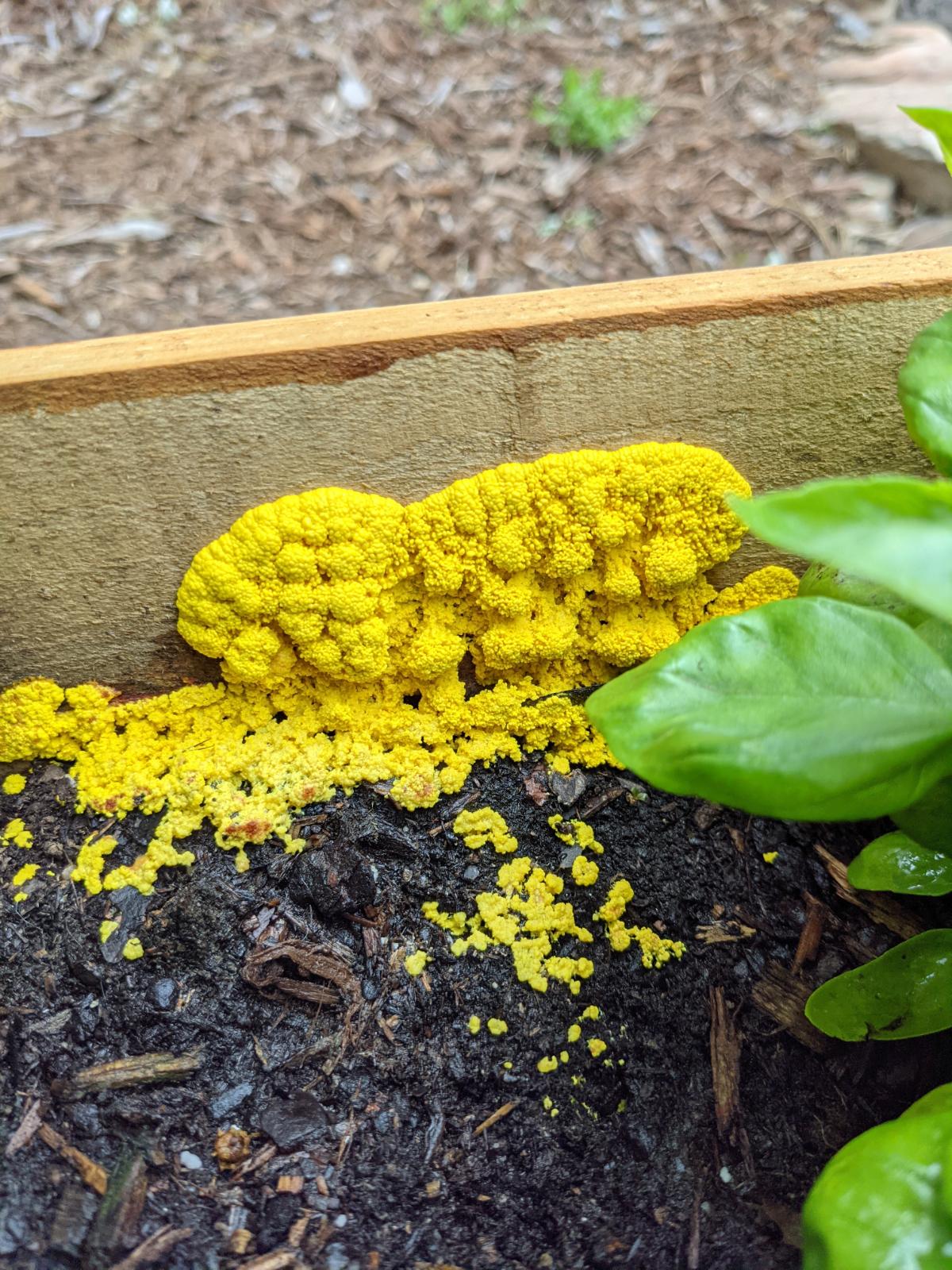
Jump to:
- All About The Dog Vomit Slime Mold
- Identifying the Dog Vomit Slime Mold
- The Life Cycle of the Dog Vomit Slime Mold
- The Ecological Significance of the Dog Vomit Slime Mold
- Humans and the Dog Vomit Slime Mold
- Controlling and Managing the Dog Slime Mold
- Culinary and Medicinal Considerations
- Embracing the Dog Slime Mold
All About The Dog Vomit Slime Mold
The dog vomit slime mold is not actually a fungus, as it was once believed to be, but rather a member of the Myxomycetes, or plasmodial slime molds, a group of primitive organisms more closely related to amoebas and certain seaweeds. This slime mold is known in Scandinavia as “troll cat vomit.”
In Finnish folklore, it was believed witches used the slime mold to spoil their neighbors’ milk. This association earns the slime mold the name paranvoi, which translates to “butter of the familiar spirit.” In Dutch, the word for this slime mold, “heksenboter,” translates to “witches’ butter.” In Latvian, the slime mold, along with other slime molds, are called “ragansviests,” which translates to “witches’ butter” or “raganu spļāviens,” which means “witches’ spit.”
The earliest documented description dates back to 1727, when French botanist Jean Marchant called it “fleur de tan” or “bark flower.” Carl Linnaeus later gave the species the Latin name Mucor septicus, which translates to “septic mucus,” alluding to its rather unsavory appearance. It wasn’t until 1780 that the species was reclassified into the genus Fuligo, earning it the scientific name Fuligo septica that we know today. The scientific descriptor septica translates to “rotten” or “putrefying.”
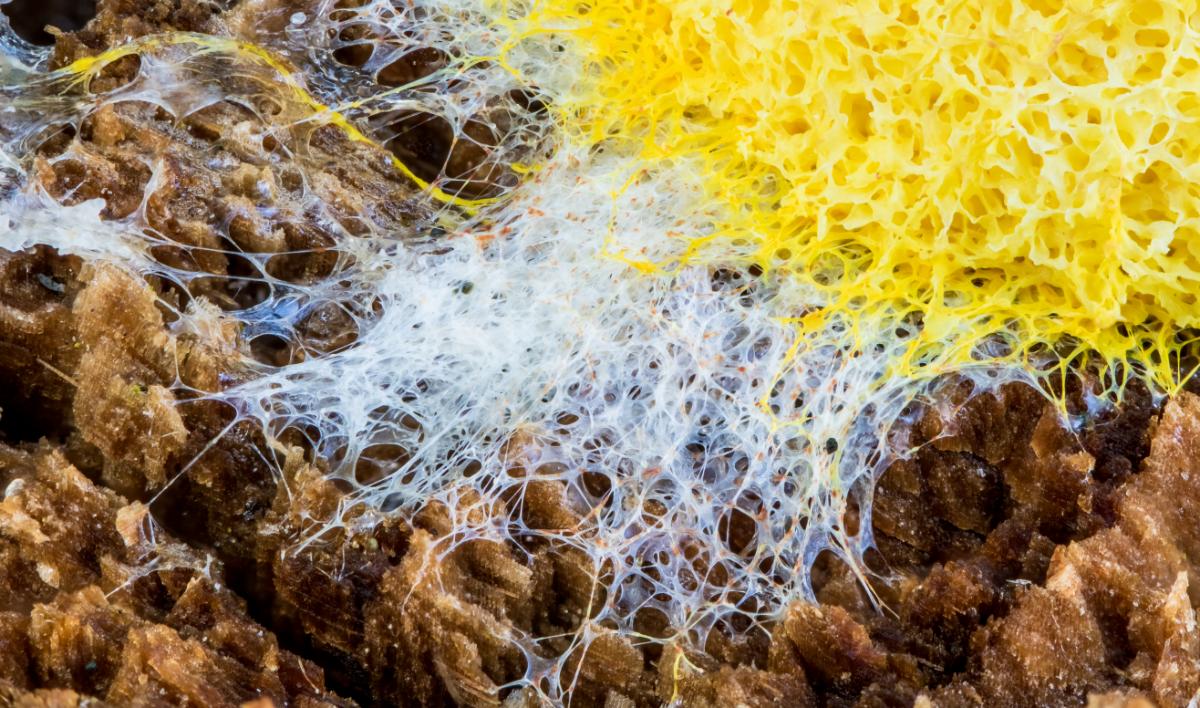
Identifying the Dog Vomit Slime Mold
Season
The dog vomit slime mold is most commonly seen from late spring through the fall. It thrives in warm, humid conditions. Its appearance is often triggered by heavy rains or excessive watering, as it requires moisture to thrive.
Habitat
This slime mold is typically found in moist, shady areas with an abundance of organic matter, such as dead leaves, wood, and bark mulch. It can also occasionally be spotted on the leaves and stems of living plants, where it may appear to have “overrun” its host.
The dog slime mold is very widespread across North America and the world. It grows in urban and wild areas; anywhere there is enough organic material and moisture to supply it.
Appearance
In its early “plasmodium” stage, the dog vomit slime mold presents as a slimy, amorphous mass that can range in color from white to bright yellow or orange. The texture is fluffy, foamy, or even resembling scrambled eggs, hence its common names. As the organism matures, it transforms into a cushion-like “aethalium” structure, which can grow to impressive sizes, sometimes reaching up to 2 feet across.
As the aethalium dries out and hardens, it takes on a crusty, powdery appearance and develops a dark, reddish-brown or black color. Underneath this crust lies a mass of millions of dark, dusty spores that are released when the structure is disturbed, often in a cloud-like fashion.
Fun Fact: The dog vomit slime mold forms the largest aethalium of any other slime mold.
Taste and Odor
The dog vomit slime mold is not known to have any significant taste or odor, though the dusty spores may irritate those with respiratory conditions, such as asthma or allergies.
Lookalikes
The dog vomit slime mold is one of the most recognizable and distinctive slime molds and it does not have any lookalikes.
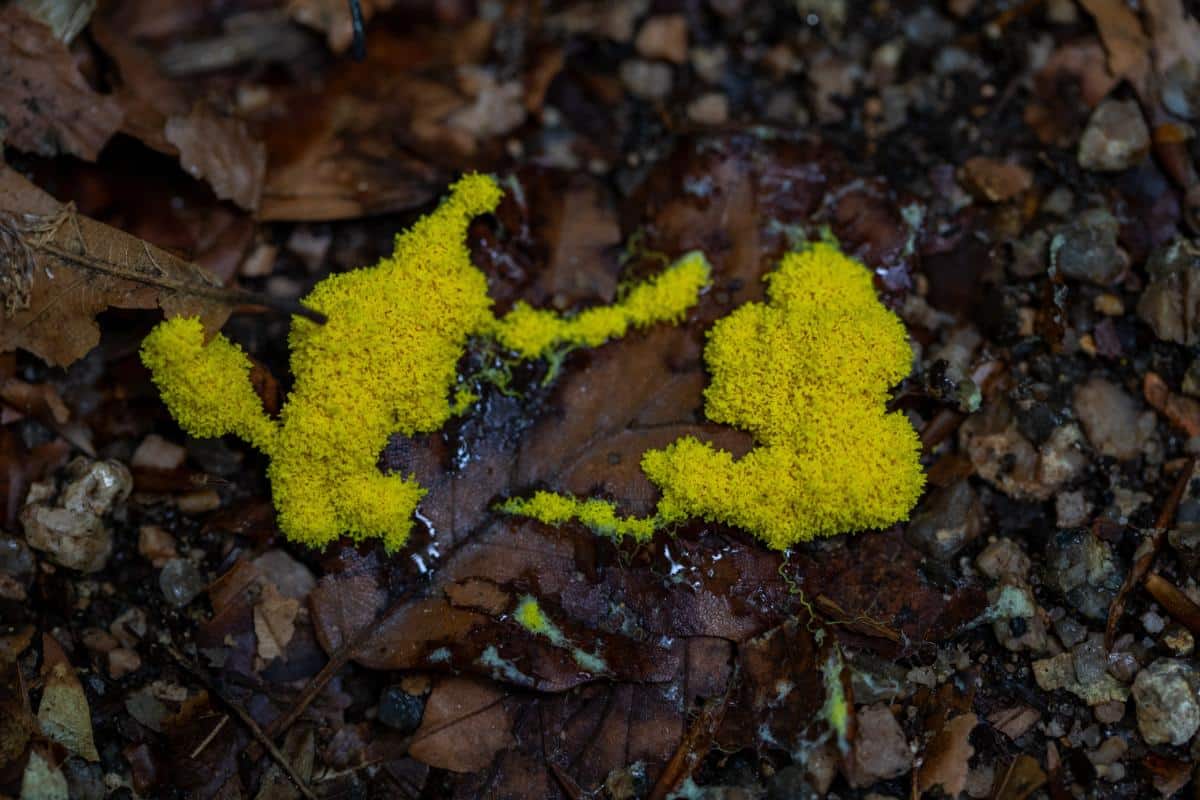
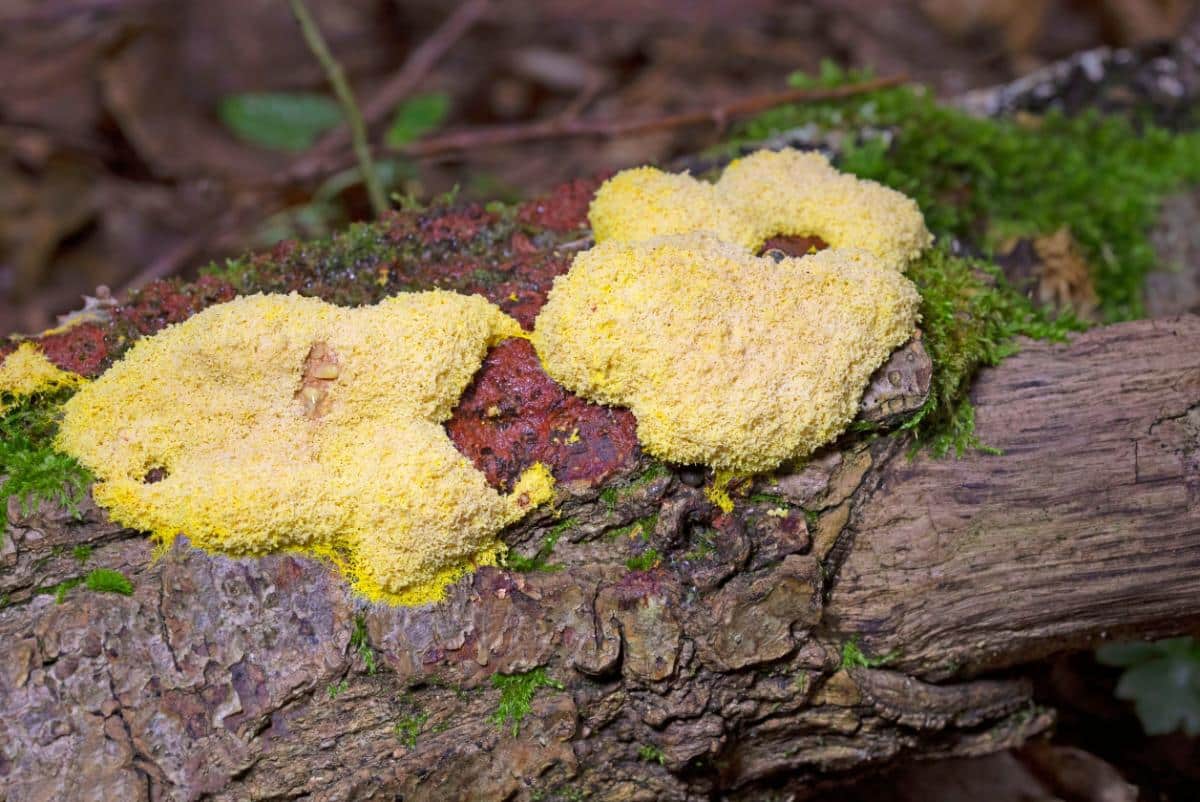
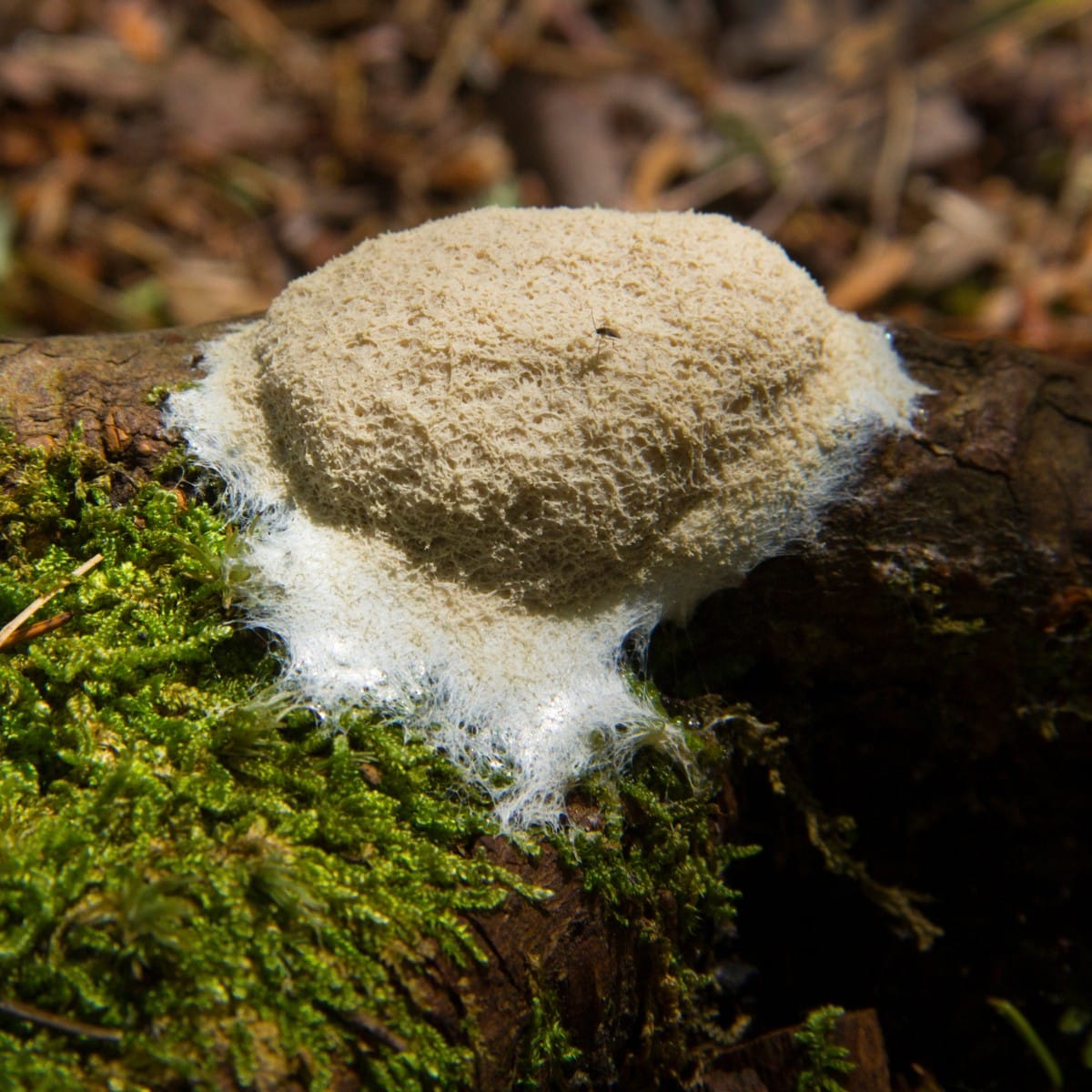
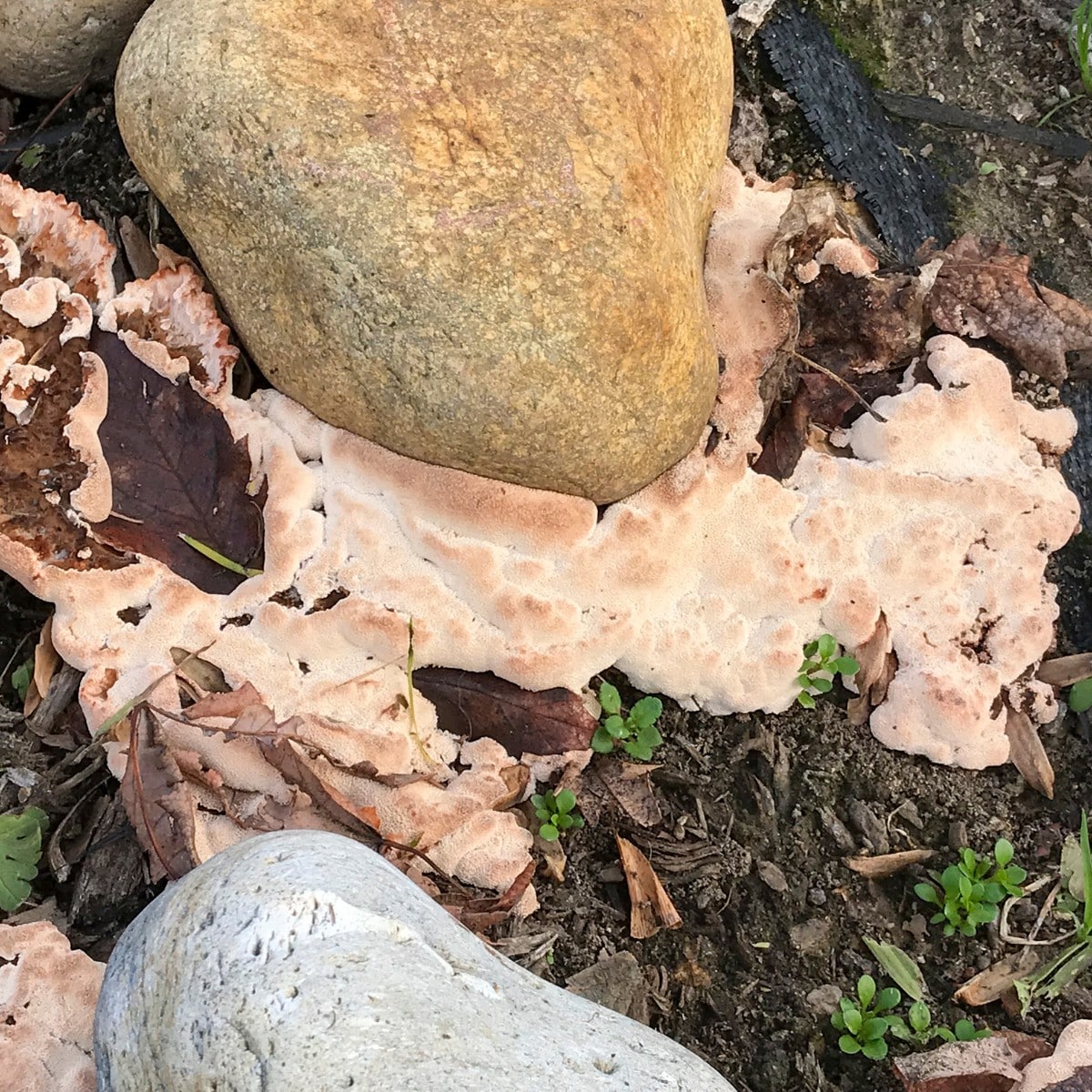
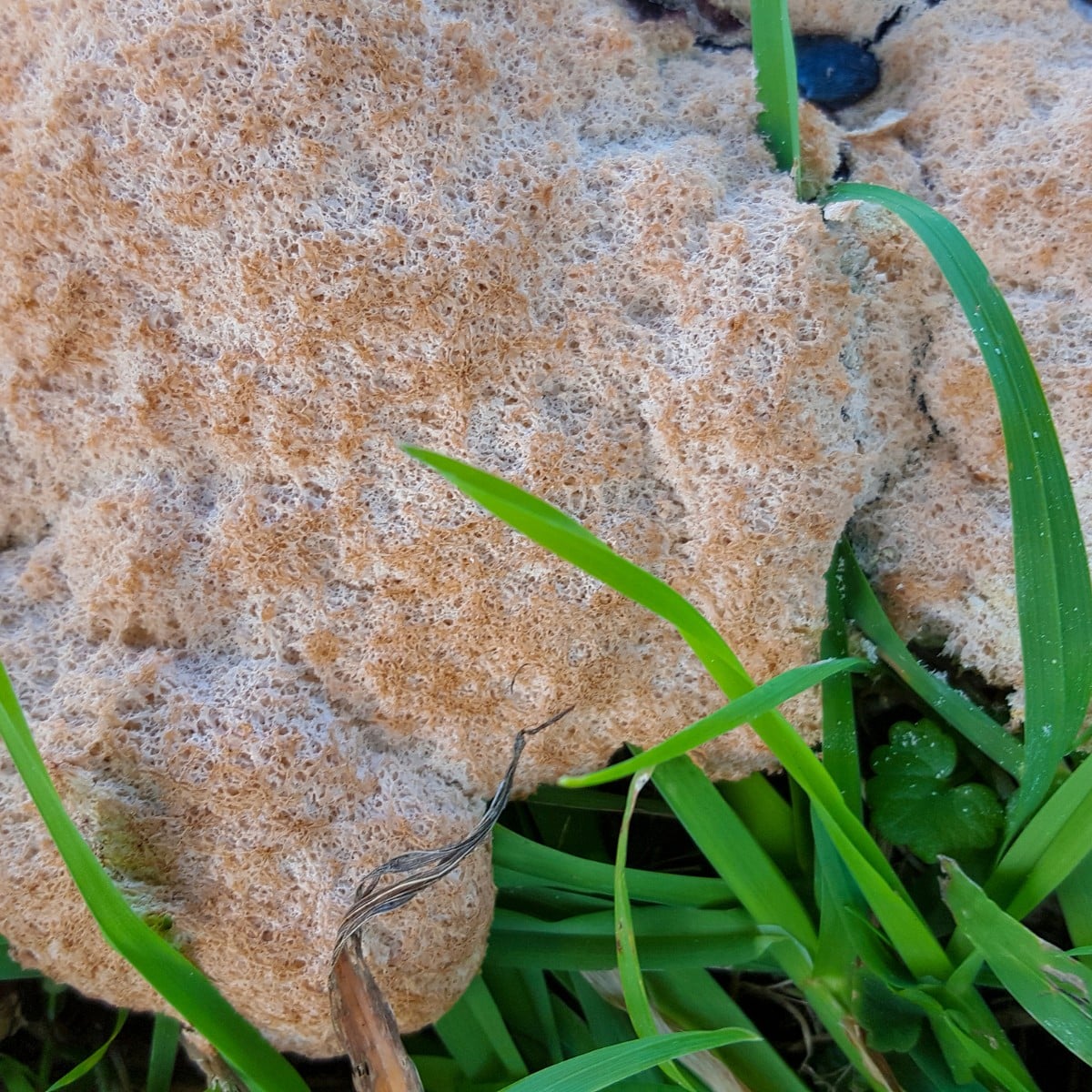
The Life Cycle of the Dog Vomit Slime Mold
Plasmodium Stage
In its early, vegetative stage, the dog vomit slime mold exists as a large, multinucleate mass of undifferentiated cells known as a plasmodium. This slimy, amorphous structure moves and flows across the substrate, engulfing bacteria, fungi, and other microorganisms as it searches for nutrients. It moves like a giant amoeba, absorbing all it comes across. If you have access to a time-lapse camera or just take pictures of the same slime mold daily, you can see it moving across the surface.
In the plasmodium stage, the slime mold is whitish, largely transparent, and crusty. It hasn’t developed its trademark fluorescent yellow color yet. At this point, it looks like an egg white—soft and transparent.
It doesn’t just spread across the ground but expands upwards to form a cushion-like shape. It looks like a small, irregularly shaped dingy-whitish pillow in the garden or woods.
Aethalium Formation
When environmental conditions become unfavorable, or the organism’s food supply is depleted, the plasmodium transforms into a spore-bearing structure called an aethalium. This cushion-like, irregularly shaped mass can grow to impressive sizes, sometimes reaching up to 2 feet across.
The transition from plasmodium to aethalium is quick—often occurring overnight or in 6-10 hours. For many people, it seems like it “just showed up” because they see the bright yellow growth. But in reality, the slime mold has been there for a while already.
The aethalium is whitish, tan, bright yellow, or orange, and fluffy or foamy. It varies significantly in size, from a few inches to up to two feet across. The surface of the slime mold sometimes develops dark red liquified areas as it ages, which makes it look like it is bleeding.
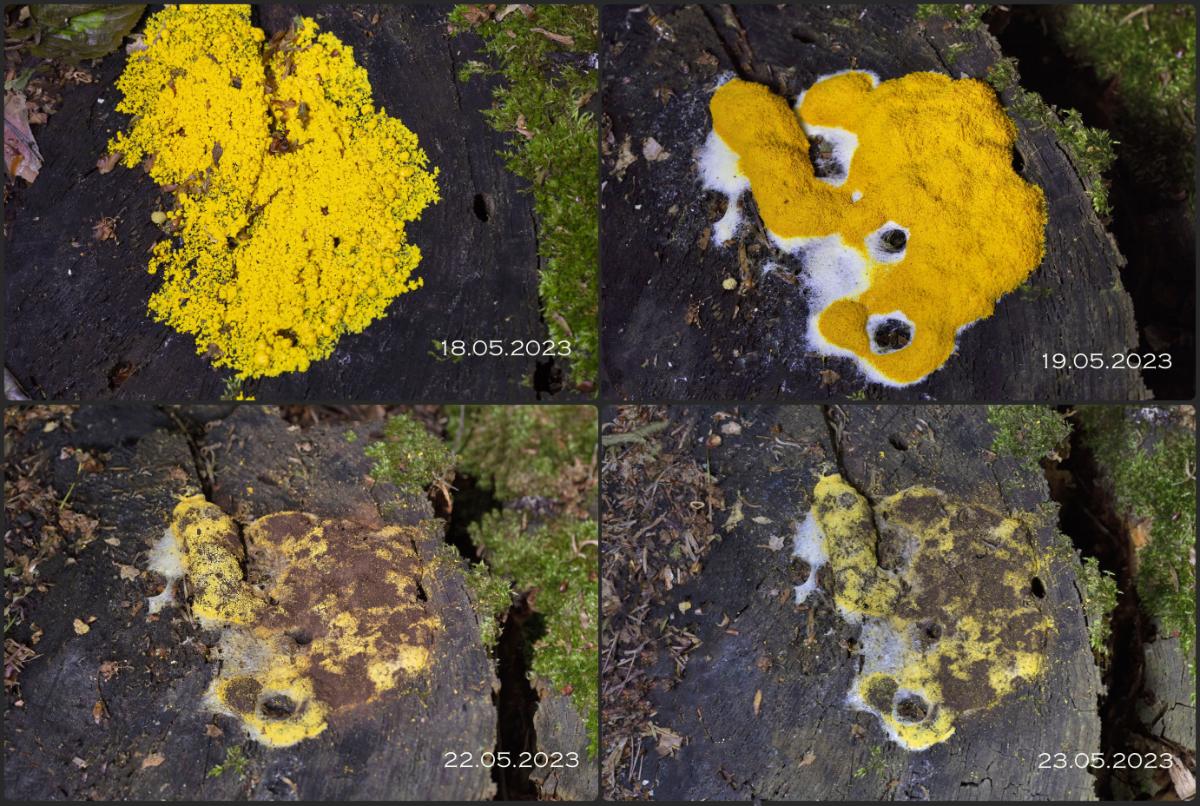
Spore Dispersal
As the aethalium matures, its outer surface becomes dry and brittle. It turns quite hard, nothing like the texture of its previous stage. Eventually, it breaks apart and releases millions of dark, dusty spores. Often, it is broken by animals, people, or a heavy rainstorm. The wind disperses these spores, allowing the dog slime mold to establish new colonies in other areas.
The dog vomit slime mold has another unique way to disperse spores. Brown scavenger beetles tunnel into the body of the slime mold and eat their fill of spores. These spores are then pooped out. Spores also attach to the beetle’s body and get transported wherever the beetle goes.
The transition from aethalium to a hardened slime mold and spore dispersal is also quick. It can happen in less than 24 hours but more often takes a few days. And once the spores are dispersed, the rest of the slime mold disintegrates and disappears.
Germination and Regeneration
When the spores encounter suitable conditions, such as warm, moist environments, they germinate, giving rise to new plasmodia and continuing this remarkable organism’s life cycle. The spores will remain dormant but viable for several years until conditions are right. The spores germinate in warm, moist conditions to form myxamoebae or flagellated swarm cells, which later fuse to form the plasmodium.
The Ecological Significance of the Dog Vomit Slime Mold
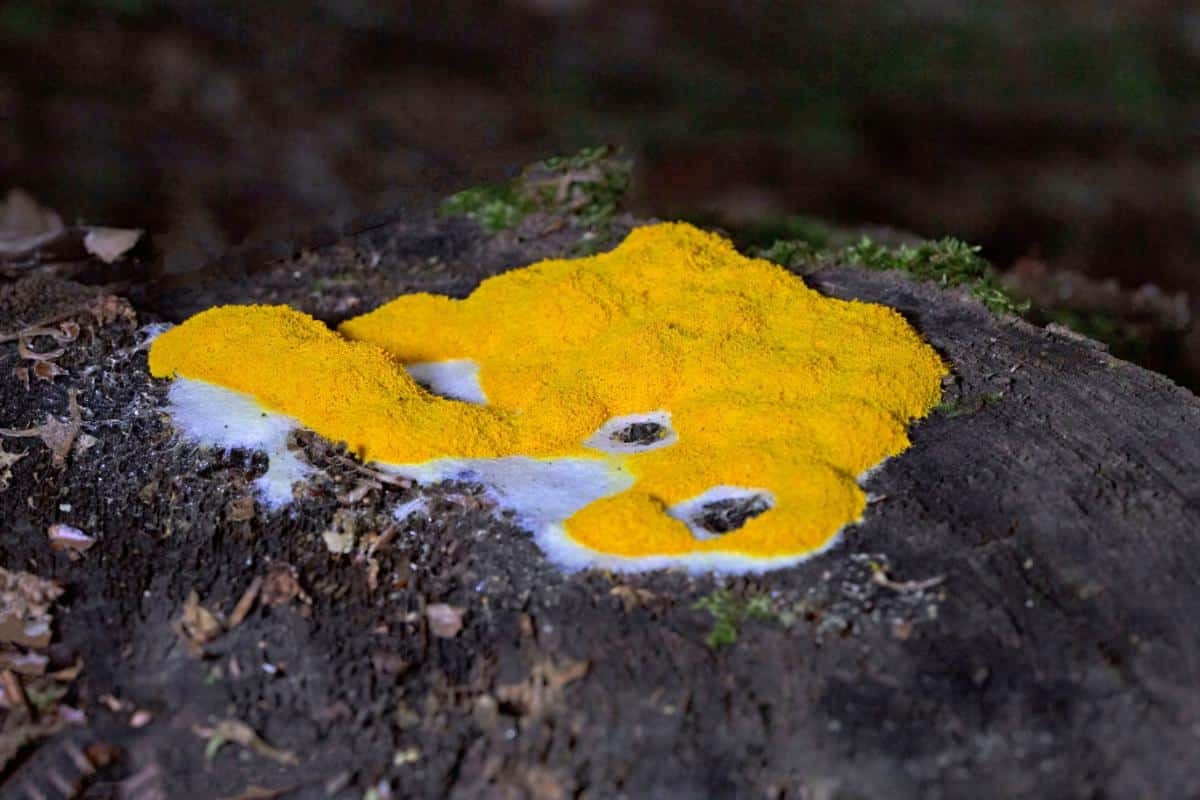
Despite its somewhat unsavory appearance, the dog vomit slime mold plays a crucial role in the natural ecosystem. As a saprophytic organism, it derives its nourishment from decaying organic matter, breaking down the tough materials that living things are made of and returning those nutrients to the soil. This decomposition process is essential for the cycling of nutrients and the maintenance of healthy, thriving ecosystems.
The dog vomit slime mold’s resistance to high levels of toxic metals, such as zinc, has been the subject of scientific study as researchers seek to understand the mechanisms behind this remarkable adaptation. This knowledge may one day lead to advancements in fields like bioremediation, where organisms are used to remove pollutants from the environment.
Humans and the Dog Vomit Slime Mold
While some gardeners may consider slime mold a nuisance, it is generally harmless to plants, pets, and humans, with the exception of the potential irritation caused by its dusty spores. Some people are allergic to it.
The primary reason humans don’t like this mold is cosmetic, i.e., it “looks” bad. Of course, this is subjective. One thing to keep in mind is that the life cycle of the dog vomit slime mold is quite short—especially in its bright yellow aethalium stage. It takes just a few days from the time you see it to the time it completely disappears.
The bright yellow scrambled eggs appearance of the dog vomit slime mold send many quickly into combat mode, assuming it is something bad. This organism isn’t problematic, though, and is actually beneficial for the garden, landscape, and the woods. This, combined with it’s very short life span, mean if you can ignore it for 3-5 days, you won’t have to deal with it again, at least for awhile. It will return every year, and that is practically impossible to prevent.
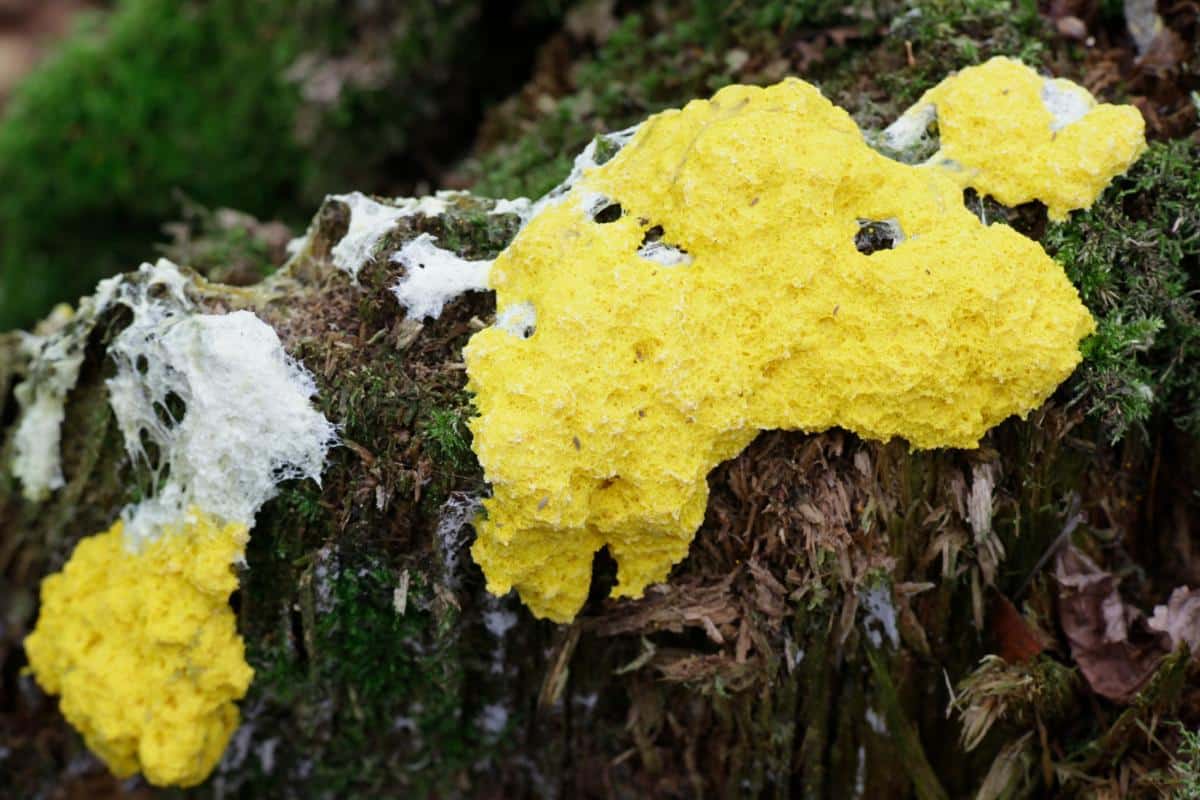
Controlling and Managing the Dog Slime Mold
For gardeners and homeowners who find the presence of the dog slime mold unsightly or problematic, a few strategies can be employed to manage its growth. However, it’s important to note that the dog slime mold is a persistent and resilient organism, and complete elimination may be nearly impossible without drastically altering the entire landscape.
The spores are in the organic material in your garden or yard, and you’d have to remove them all to eliminate the slime mold completely. We think it’s better to just accept its presence as part of the natural world and let it be — it’s not dangerous to anyone and is busy at work nutrient cycling so your plants can access all those good nutrients and grow big and strong.
- Raking or scraping the aethalium can help break it up and expose it to drying conditions, making it less noticeable.
- Stirring up the mulch can help disrupt the plasmodium and dry out the area, making it less hospitable for the slime mold.
- Replacing hardwood mulch with alternative materials, such as gravel, pine bark, or pine straw, can reduce the likelihood of the slime mold appearing.
- Reducing excessive watering can also help make the environment less favorable for the dog slime mold’s growth.
Things Not To Do:
- If you try to wash it away with a garden hose, you just give the organism more moisture and spread the spores further. The dog vomit slime mold thanks you for this.
Culinary and Medicinal Considerations
Despite its rather unappetizing appearance, the dog slime mold is actually edible in some parts of the world, particularly in Mexico. Some people report is is known known as “Caca de luna” or “moon poop,” but that more than likely refers to a different slime mold. If you’re curious about the edibility research, here’s a great place to start. It doesn’t get very far and there isn’t much about how to prepare it, but it does seem that it is collected and eaten in the plasmodium, when it looks like transparent raw egg whites.
On the medicinal front, extracts from the dog slime mold have shown promising results in laboratory studies. They exhibit antibiotic activity against certain bacteria and fungi and cytotoxic effects on certain cancer cell lines. While these findings are intriguing, further research is needed to fully understand this organism’s potential therapeutic applications.
Interestingly, the dog slime mold has also proven helpful in scientific research, particularly in the study of RNA processing and the evolution of genetic mechanisms. Its large number of group I introns, a type of genetic element, has made it a valuable model organism for understanding the complex processes involved in gene expression and regulation.
Embracing the Dog Slime Mold
The dog slime mold is one of the captivating oddities of the natural world. Its sudden appearance, vibrant colors, and remarkable life cycle have the power to inspire wonder, curiosity, and a deeper appreciation for the incredible diversity of life that surrounds us.
Rather than viewing the dog slime mold as a mere nuisance, we can embrace it as a fascinating and valuable part of our ecosystems, one that reminds us of the boundless creativity and resilience of nature. By learning about its unique characteristics and its roles in the broader web of life, we can cultivate a greater respect and fascination for this remarkable organism and perhaps even find inspiration in its ability to thrive in the most unexpected places.





Leave a Reply